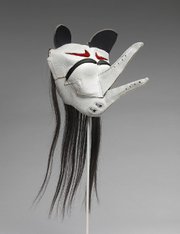There is no one Indigenous perspective ... no one Indigenous story. We are tremendously diverse peoples with tremendously diverse life experiences. We are not frozen in the past ...
-- Wab Kinew, quoted in Dreaming in Indian: Contemporary Native American Voices
BENTONVILLE -- There's so much to explore and experience by viewing Art for a New Understanding: Native Voices--1950s to Now. The latest exhibition to open at Crystal Bridges Museum of American Art seeks to overturn the cliched image of Native Americans as noble savages in braids and buckskins through an exhilarating display of thoroughly modern paintings, photography, video, textiles, sculpture, performance art and more created by 40 indigenous artists from the United States and Canada.
The exhibition, says co-curator Manuela Well-Off-Man, "tells a more inclusive story" intended to "confront the complexities of contemporary indigenous life and the contributions they have made to modern and contemporary American art."
Works are by "artists that aren't usually included in contemporary exhibits," says co-curator Mindy Besaw. "We're going to correct that."
A good place to start is Kent Monkman's History is Painted by the Victors, which uses American art history and the presence of the engaging figure of Miss Chief Eagle Testickles (in thigh-high pink boots) to upend manifest destiny, a belief that justified U.S. government policies of annihilation, assimilation, and removal of indigenous peoples from their lands. Glum? No, it's surprising and amusing. "It's fun and funny; you're meant to laugh," says Besaw.
Most memorable is Prototypes for New Understanding (from which the exhibition takes its name), a series of 23 works made by artist Brian Jungen between 1998 and 2003, that transforms Nike Air Jordans into sculptures that share similarities with Northwest Coast masks. That's how the description goes, but the word "transforms" is hardly powerful enough to convey the effect of Jungen's imaginative and provocative work.
The idea, the curators say, is to call attention to the ways images in popular culture shape an understanding of indigenous peoples.
And the point of it all is made clear by Fritz Scholder's shivery oil painting Monster Indian, which came about because of his frustration with the way diverse groups of people had been reduced to a stereotype of an "American Indian." When you see it, you'll get his point.
The exhibition continues through Jan. 7. Admission is free.
If all this modernity leaves you craving a reminder of where this art--and these cultures--came from, and you happen to be in Bentonville, you might want to visit the nearby Museum of Native American History.
This privately owned nonprofit, about three minutes from Crystal Bridges, is housed in an unassuming, attractive building hidden in a pleasantly nondescript residential neighborhood. Except for the big teepee near the entrance, you'd never know it's positively stuffed with a stunning array of some 10,000 artifacts from across the Americas.
Inside is an illuminating look at over 14,000 years of period-arranged history from Paleo (8,000 to 12,000 B.C.; the star is an authentic woolly mammoth skeleton that greets visitors at the entrance) to Archaic (hunters and gatherers, from 10,000 years ago), Woodlands (signified by widespread use of pottery; 1,000 B.C. to 900 A.D.) Mississippian (900 A.D. to 1450 A.D., when agriculture and art kicked in), Historic ((1650 A.D. to 1900 A.D., which explores the first contact between Native Americans and Europeans), and Pre-Columbian (when temples, pyramids, and cities started to show up before Columbus did in 1492).
If you can find an arrowhead in the gravel surrounding the outdoor teepee, it's yours for 50 cents. Those who come up empty-handed can find a souvenir (the colorful beaded bookmarks are my favorite) in the well-stocked gift shop.
Many of the treasures on display--all authentic, no replicas--come from the collection of museum founder and chairman David Bogle, a Bentonville native with Cherokee ancestry, and were discovered in Arkansas and surrounding states.
Does this make you feel like yawning? Does it sound like the dusty just-the-facts high school stuff that you often find history to be? Think again. I went in expecting to spend a half-hour or so gawking at some pottery, tools, and lumpy animal carvings before heading downtown to see what's new on the ever-expanding Bentonville restaurant scene.
I was there for over two hours.
The high point for me came in a gallery filled with glass-protected displays of precision-crafted headdresses, bows and arrows, ceremonial costumes (heavily embroidered and beaded), unique kids' toys and sandals, battle axes, haunting 19th-century photographs, paintings, and gorgeous weavings--so engaging, so visceral that my hand kept reaching out to try to touch them.
A friend who had visited recently had the same experience. "If I knew what was coming, I wouldn't have spent so much time on the arrowheads," she said.
The museum is at 202 SW O St., Bentonville. Admission is free.
Karen Martin is senior editor of Perspective.
Editorial on 10/14/2018

